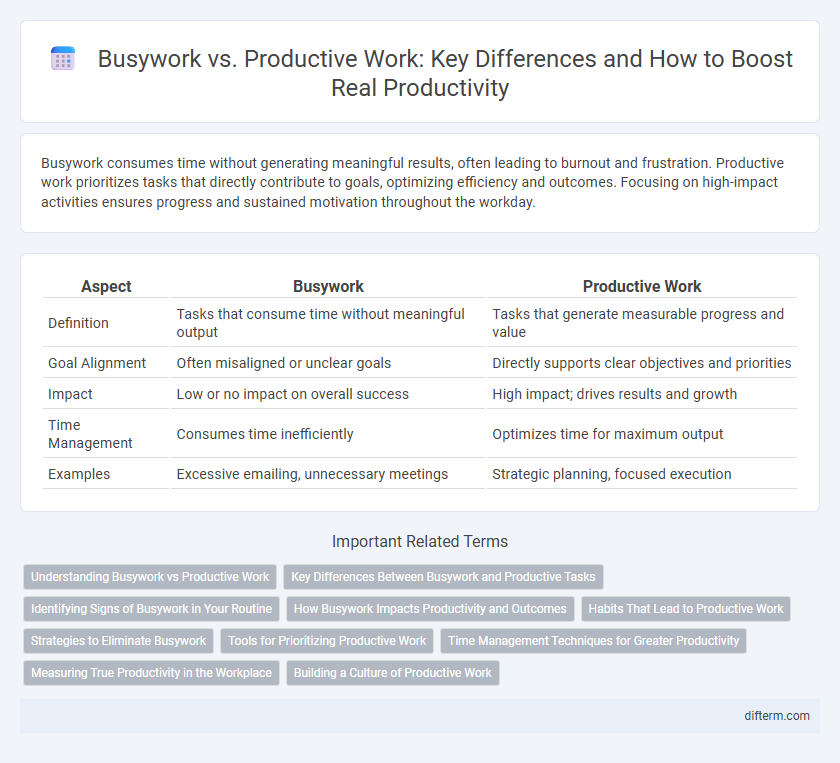Busywork consumes time without generating meaningful results, often leading to burnout and frustration. Productive work prioritizes tasks that directly contribute to goals, optimizing efficiency and outcomes. Focusing on high-impact activities ensures progress and sustained motivation throughout the workday.
Table of Comparison
| Aspect | Busywork | Productive Work |
|---|---|---|
| Definition | Tasks that consume time without meaningful output | Tasks that generate measurable progress and value |
| Goal Alignment | Often misaligned or unclear goals | Directly supports clear objectives and priorities |
| Impact | Low or no impact on overall success | High impact; drives results and growth |
| Time Management | Consumes time inefficiently | Optimizes time for maximum output |
| Examples | Excessive emailing, unnecessary meetings | Strategic planning, focused execution |
Understanding Busywork vs Productive Work
Busywork often involves low-value tasks that consume time without advancing key goals, while productive work directly contributes to achieving meaningful results and business objectives. Distinguishing between these types of work requires evaluating each task's alignment with strategic priorities and measurable outcomes. Effective time management hinges on prioritizing tasks that drive progress rather than merely filling the schedule.
Key Differences Between Busywork and Productive Tasks
Busywork consists of low-impact tasks that create the illusion of productivity without contributing significantly to goals, often involving repetitive or administrative activities. Productive work targets high-value objectives, advances key projects, and directly aligns with strategic outcomes that drive measurable progress. Understanding the key differences lies in evaluating task impact, purpose, and alignment with broader business or personal goals.
Identifying Signs of Busywork in Your Routine
Busywork often involves repetitive tasks that consume time without contributing to meaningful goals or progress, such as excessive email checking or unnecessary meetings. Identifying signs of busywork includes recognizing activities that lack clear outcomes, fail to advance projects, and create constant distraction from priority tasks. Focusing on results-driven responsibilities and setting measurable objectives helps distinguish productive work from mere busyness.
How Busywork Impacts Productivity and Outcomes
Busywork often consumes significant time and energy without contributing to meaningful progress, leading to decreased overall productivity and suboptimal outcomes. This misallocation of resources results in employee burnout and diminished focus on high-impact tasks that drive business goals. Prioritizing productive work over busywork enhances efficiency, innovation, and long-term success.
Habits That Lead to Productive Work
Habits that lead to productive work prioritize tasks with clear goals and measurable outcomes, avoiding busywork that consumes time without advancing objectives. Effective time management techniques, such as the Pomodoro method and prioritizing high-impact activities, enhance focus and efficiency. Consistently reviewing and adjusting workflows ensures alignment with strategic goals and reduces unnecessary effort.
Strategies to Eliminate Busywork
Identifying and categorizing tasks based on their impact on core goals enables the elimination of busywork that consumes time without delivering value. Implementing time-blocking techniques and prioritizing high-impact activities ensures focused effort on productive work that drives measurable results. Leveraging automation tools and delegating repetitive chores further reduces unnecessary workload, optimizing overall productivity.
Tools for Prioritizing Productive Work
Effective tools for prioritizing productive work include task management apps like Todoist and Trello, which help organize and rank tasks based on urgency and impact. Time-tracking software such as RescueTime provides insights into work habits, enabling users to identify and minimize busywork. Implementing the Eisenhower Matrix within digital tools assists in distinguishing critical tasks from low-value activities, enhancing focus on high-priority goals.
Time Management Techniques for Greater Productivity
Prioritizing tasks using time management techniques such as the Pomodoro Technique and Eisenhower Matrix effectively distinguishes productive work from busywork by focusing efforts on high-impact activities. Allocating specific time blocks for deep work enhances concentration and reduces distractions, maximizing output quality within limited time frames. Regularly reviewing task relevance ensures alignment with overarching goals, preventing time wastage on low-value busywork and promoting sustained productivity growth.
Measuring True Productivity in the Workplace
Measuring true productivity in the workplace requires distinguishing between busywork and productive work by evaluating output quality and alignment with key performance indicators (KPIs). Tracking task completion rates alongside value-added results enables managers to identify activities that contribute directly to organizational goals. Leveraging productivity analytics tools provides data-driven insights to optimize workflows and enhance overall effectiveness.
Building a Culture of Productive Work
Creating a culture of productive work requires prioritizing tasks that drive meaningful outcomes over busywork that merely fills time. Emphasizing goal-oriented activities and clear performance metrics fosters employee engagement and enhances overall efficiency. Organizations that cultivate this mindset see improved project completion rates and higher employee satisfaction.
Busywork vs Productive work Infographic

 difterm.com
difterm.com